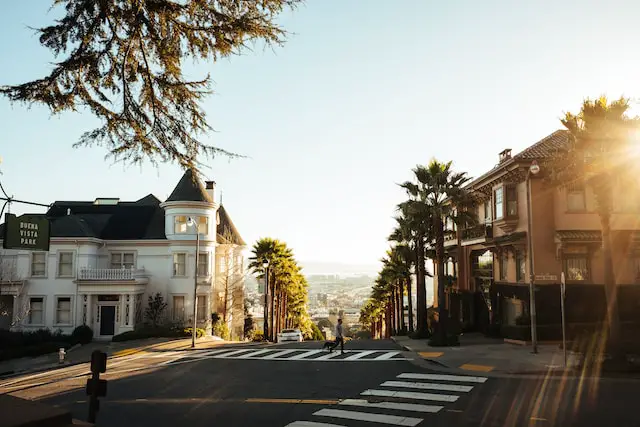Palm Springs may be a popular destination for tourists seeking sunny skies and relaxing getaways, but for those who call it home, there are some challenges and drawbacks to residing in this desert oasis.
From extreme heat to water scarcity and limited job opportunities, there are many factors that can make living in Palm Springs less than ideal for some. In this article, we’ll explore some of the bad things about living in Palm Springs and provide an overview of the challenges residents may face.
Key Takeaways:
- Palm Springs has a harsh desert climate that can make living uncomfortable, especially during the summer months.
- The high cost of living in Palm Springs can be challenging for some residents, with housing prices and utility expenses among the highest in the country.
- Job opportunities in Palm Springs are limited, making it difficult for some residents to find suitable employment and career prospects.
- The seasonal tourism industry can bring crowds and traffic congestion to Palm Springs, particularly during peak seasons.
- Palm Springs may not offer as many cultural and entertainment options as larger metropolitan areas, which could be a drawback for some residents.
Extreme Heat and Desert Climate
Palm Springs is located in the Sonoran Desert, which means that the climate is characterized by hot summers and mild winters. The extreme heat and dry climate can make living in Palm Springs uncomfortable, particularly during the peak summer months.
High Temperatures
The temperatures in Palm Springs can reach above 110 degrees Fahrenheit during the summer season. This kind of heat can be dangerous, especially for vulnerable populations such as the elderly and children. It’s important to stay hydrated and take necessary precautions when spending time outdoors during this time of year.
Dry Climate
The desert climate in Palm Springs is very dry, which can have negative effects on skin, hair, and respiratory systems. The lack of moisture in the air can lead to dry skin and chapped lips, as well as aggravating conditions such as asthma and allergies.

Seasonal Climate Changes
Additionally, two seasons dominate the climate in Palm Springs: the hot season and the mild season. The hot season makes up the majority of the year, while the mild season is shorter and occurs during the winter. Visitors and residents must be prepared for both extremes in order to enjoy their time in the desert climate.
Overall, the extreme heat and desert climate in Palm Springs can be challenging for many people. However, with proper precautions and measures in place, residents can still enjoy all that Palm Springs has to offer.
High Cost of Living in Palm Springs
Living in Palm Springs can be an expensive lifestyle choice, with the high cost of living being a major consideration for many residents. For instance, housing prices in the area are known to be among the highest in California, with the median home value in Palm Springs being close to $500,000. As such, many residents have to contend with steep mortgage payments or rent, which can eat up a significant portion of their income.
In addition to housing, other expenses in Palm Springs can also be quite high. For example, utility bills such as electricity, gas, and water can add up quickly, especially during the hot summer months. The cost of groceries and other daily necessities can also be higher than in other areas, further contributing to the overall expense of living in Palm Springs.
The Challenge of Affordability
For many residents, the high cost of living in Palm Springs can be a challenge to their overall financial well-being. To make ends meet, they may have to make sacrifices in other areas, such as entertainment or travel. The cost of healthcare and insurance can also be expensive, which can add to the financial burden of living in Palm Springs.
Despite these challenges, many residents are willing to pay the price for the benefits that Palm Springs offers, such as its pleasant climate, proximity to outdoor attractions, and relaxed lifestyle. However, for those who are struggling to make ends meet, the high cost of living in Palm Springs can make it difficult to maintain a comfortable standard of living.
Conclusion
In summary, the high cost of living in Palm Springs is a major factor that residents have to contend with in their daily lives. While the area offers many benefits, such as pleasant weather and plentiful outdoor attractions, it is important to be aware of the expenses that come with residing in this popular destination.
Limited Job Opportunities
Living in Palm Springs may present challenges for those seeking employment opportunities. The Palm Springs job market is relatively small, with limited options for career advancement and growth.
Residents may find it challenging to secure full-time, long-term employment, particularly in industries outside the leisure and hospitality sectors. Many businesses in Palm Springs rely heavily on seasonal tourism, which may lead to a fluctuating job market throughout the year.
The Impact on Residents
The limited job opportunities in Palm Springs may affect residents’ overall financial stability and quality of life. Some individuals may struggle to find employment that can provide adequate compensation and benefits to support themselves and their families.
The lack of available employment options may also affect the ability of the local economy to attract and retain talent, leading to a potential loss of skilled workers.
Seeking Employment in Palm Springs
Despite the challenges, there are still job opportunities available in Palm Springs. Those with experience in the tourism and hospitality industries may find success in securing employment in the bustling seasonal tourism sector.
Additionally, residents may need to expand their job search beyond Palm Springs, considering nearby cities such as Palm Desert or Rancho Mirage for potential employment opportunities.
Conclusion
While the limited job opportunities in Palm Springs may pose challenges for residents, there are still options available for those seeking employment. By exploring various industries and expanding their job searches, residents may be able to find success in the job market and enjoy their experiences living in Palm Springs.
Seasonal Tourism and Crowds
Palm Springs is known for its stunning natural beauty and world-class attractions, which draw in thousands of tourists every year. However, this popularity also brings with it some significant drawbacks, especially during peak seasons.
Seasonal Tourism
The tourism industry in Palm Springs is primarily seasonal, with most visitors arriving during the winter months to enjoy the mild weather and outdoor activities. While this influx of tourists is undoubtedly good for the local economy, it also means that residents must contend with crowded streets and packed attractions for several months each year.
Crowded Streets and Attractions
During the peak season, getting around Palm Springs can be challenging due to the high volume of tourists. The streets can become congested, making it difficult to navigate and increasing travel times. Additionally, popular attractions such as the Palm Springs Aerial Tramway and the Coachella Valley Preserve can quickly become overcrowded, detracting from their appeal and making it challenging to enjoy the natural beauty of the area.
Overall, seasonal tourism can contribute to crowded streets and attractions, which can be a significant drawback for those living in Palm Springs. While visitors may find the hustle and bustle exciting, residents may find it overwhelming and disruptive to their daily lives.
Traffic and Transportation Challenges
One of the significant challenges for those living in Palm Springs is the traffic congestion and transportation issues that can occur. Due to the city’s rapid growth and popularity as a tourist destination, the roads and highways can often become overcrowded, leading to long commute times and delays.

Residents who rely on public transportation can also face challenges as the public transit system is limited and may not cover all areas of the city. This can make it difficult and time-consuming to get around. Additionally, the lack of bike lanes and pedestrian-friendly infrastructure can make it unsafe for those who choose to walk or bike to their destination.
Addressing the Issues
Despite these challenges, there are some measures being taken to address traffic and transportation issues in Palm Springs. The city has initiated several projects aimed at improving transportation infrastructure, such as expanding the Palm Springs International Airport and adding new bike lanes and pedestrian walkways.
Residents are also encouraged to take part in alternative transportation modes, such as carpooling or using ride-sharing services to reduce traffic congestion. Additionally, the city has plans to improve the public transportation system to make it more accessible and convenient for residents.
The Bottom Line
While traffic and transportation challenges in Palm Springs can be frustrating, there are efforts being made to address these issues and make it easier for residents to get around. However, until more significant improvements are made, it’s essential to plan accordingly and allow extra time for commuting and travel.
Limited Cultural and Entertainment Options
While Palm Springs offers numerous opportunities for outdoor activities and exploration, it may fall short in terms of cultural and entertainment options. Compared to larger metropolitan areas, the cultural scene in Palm Springs can be relatively small and limited.
Residents looking for a diverse cultural experience may find themselves lacking options, such as theaters, concert halls, and museums. Additionally, the nightlife scene may not be as vibrant as in larger cities, with limited opportunities for clubbing, bar hopping, or late-night entertainment.
However, Palm Springs does have some cultural and entertainment options worth exploring, such as the Palm Springs Art Museum, the Agua Caliente Casino, and the McCallum Theatre. Moreover, the city is home to numerous art galleries and hosts several cultural festivals and events throughout the year.
Art and Culture in Palm Springs
The Palm Springs Art Museum is a cultural gem in the city and features a wide range of art exhibitions and galleries, including contemporary, Native American, and Western art. The museum also hosts several events and lectures throughout the year, making it an excellent resource for art enthusiasts and students.
The city is also home to numerous art galleries, such as Heather James Fine Art, Imago Galleries, and Melissa Morgan Fine Art. These galleries host exhibitions and events showcasing a diverse range of art styles and artists.
Entertainment in Palm Springs
While the nightlife scene in Palm Springs may not be as extensive as in larger cities, there are still several entertainment options worth exploring. For instance, the Agua Caliente Casino offers a variety of gaming options, including slot machines, table games, and bingo. The casino also features several restaurants, a spa, and a live entertainment venue.
The McCallum Theatre is another entertainment venue worth checking out, featuring a wide range of performances, including musicals, plays, and concerts. The theater also offers educational programs and workshops for aspiring performers and students.
Overall, while Palm Springs may have limited cultural and entertainment options compared to bigger cities, it still offers plenty of opportunities for residents to explore and engage with art, culture, and entertainment in their unique desert environment.
Water Scarcity and Conservation
Living in a desert region like Palm Springs means that residents must contend with the challenges of water scarcity and the need for water conservation. With lower-than-average rainfall and limited access to water resources, the local environment demands careful management of this precious resource.

The City of Palm Springs has implemented various strategies to promote water conservation, including mandatory water restrictions, rebates for water-efficient appliances, and educational programs to encourage residents to reduce their water usage. By making small changes such as fixing leaky faucets and using drought-resistant landscaping, individuals can contribute to the overall effort to conserve water.
The Importance of Water Conservation
Water conservation is crucial for maintaining the delicate balance of the Palm Springs ecosystem. The region’s natural beauty and unique flora and fauna rely on sustainable use of water resources. In addition, the local economy, which depends heavily on tourism, may suffer if water scarcity becomes more severe.
By engaging in water-conscious behaviors and adhering to conservation regulations, Palm Springs residents can help protect their community and ensure that future generations can enjoy the area’s natural wonders.
Seasonal Winds and Dust Storms
Palm Springs is no stranger to seasonal weather phenomena, and one of the most noteworthy is the arrival of the winds and dust storms. These winds, dubbed the “Santa Anas,” can whip through the area and cause significant disruption and inconvenience to residents.
The Santa Ana Winds
The Santa Ana winds typically arrive in Palm Springs in the fall, but they can arrive at other times of the year as well. These dry, hot winds originate from the Great Basin in Nevada and can quickly pick up speed as they descend from the mountains into Palm Springs.
When they arrive, the Santa Anas can cause a variety of problems for residents. First and foremost, they are incredibly hot and dry, which can exacerbate already high temperatures and create a fire risk. They can also bring dust and debris with them, making it difficult to breathe and reducing visibility on the roads.
Dust Storms
In addition to the Santa Ana winds, Palm Springs is also prone to dust storms. These storms occur when strong gusts of wind pick up dust and dirt from the ground and create a wall of swirling debris.
Dust storms can be dangerous because they can cause accidents on the roads, damage to property, and health problems for those with respiratory issues. They can also make it difficult to see and navigate, which is especially concerning for drivers.
Mitigating the Effects
While it’s impossible to prevent the arrival of the Santa Anas and dust storms, there are measures that residents can take to mitigate their effects. For example, they can seal their homes to keep dust out, avoid outdoor activities during times of high wind, and prepare emergency kits in case of power outages or other disruptions.
The city of Palm Springs also takes steps to prepare for these weather phenomena, including clearing storm drains and trimming trees to prevent damage from falling branches. Additionally, they provide resources and information to residents so that they can be informed and prepared.
Overall, while the seasonal winds and dust storms can be a challenge, they are simply a part of the unique climate and environment of Palm Springs.
Lack of Diversity and Inclusivity
Unfortunately, Palm Springs can fall short when it comes to diversity and inclusivity issues within the community. While the city has taken steps to promote diversity, some groups may still experience challenges in terms of inclusion.
In terms of ethnic diversity, Palm Springs has a predominantly white population, with Hispanic/Latino and Black residents making up a smaller percentage. This lack of diversity can lead to a lack of representation and understanding for minority groups. Additionally, certain neighborhoods in the city may be less welcoming or accessible to those who do not fit the dominant demographic.
The LGBTQ+ community is an important part of the Palm Springs community and the city has a reputation for being welcoming to this group. However, there is still work to be done to ensure that all members of the community feel fully accepted and supported.
People with disabilities may also face challenges in terms of accessibility and accommodation in some areas of Palm Springs.
As with many communities, there is always room for improvement in terms of inclusivity and diversity. By recognizing these issues and taking action to address them, Palm Springs can continue to grow as a welcoming and inclusive city for all.
Conclusion
In summary, while Palm Springs offers many positive qualities, such as beautiful scenery and a warm climate, there are several drawbacks to living in this desert city. The extreme heat and harsh climate, high cost of living, limited job opportunities, seasonal tourism and crowds, traffic and transportation challenges, limited cultural and entertainment options, water scarcity and conservation, seasonal winds and dust storms, and lack of diversity and inclusivity are just some of the challenges that residents may encounter.
However, it is important to note that these negative aspects may not apply to every individual, and some may find the benefits of living in Palm Springs to outweigh the drawbacks. It ultimately comes down to personal preferences and priorities.
For those who do choose to reside in Palm Springs despite the drawbacks, there are measures that can be taken to mitigate the challenges, such as utilizing public transportation, conserving water, and seeking out diverse communities and cultural offerings.
Overall, while there are certainly bad things about living in Palm Springs, it remains a unique and interesting place to call home, with its own set of advantages and drawbacks that may appeal to different individuals.

